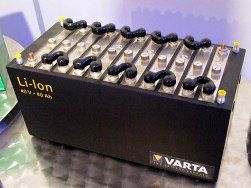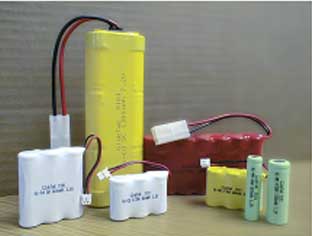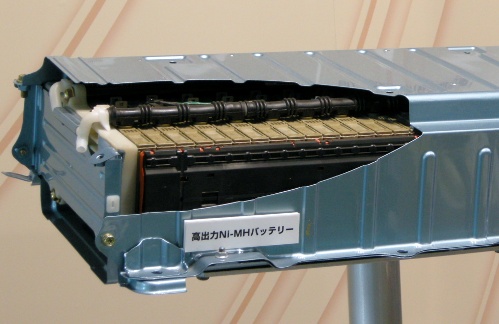Categories: Featured Articles » Interesting Facts
Number of views: 27897
Comments on the article: 5
Popular Battery Types
The device (in a few words), advantages and disadvantages. Lead-acid, nickel-cadmium, nickel-metal hydride and lithium-ion batteries.
 Battery technology quietly and firmly entered our lives. Cordless phones, cell phones, cordless power tools, cameras, a variety of toys ... If all this received electricity only from ordinary acid or alkaline batteries, then a significant share of the budget of every Russian family would be spent on batteries. Therefore, you often catch yourself thinking: how did we even live without household batteries?
Battery technology quietly and firmly entered our lives. Cordless phones, cell phones, cordless power tools, cameras, a variety of toys ... If all this received electricity only from ordinary acid or alkaline batteries, then a significant share of the budget of every Russian family would be spent on batteries. Therefore, you often catch yourself thinking: how did we even live without household batteries?
Batteries - These are electrochemical devices capable of storing and giving off electric energy. However, behind such a simple definition lies a wide variety of designs and principles of operation of various batteries. Evolution and technological progress have fully affected them and today in industry there are rechargeable batteriescapable of working with maximum power for literally years without recharging.
However, the average layman is only familiar with several types of batteries. Let us dwell on them in more detail.
In the on-board power systems of our cars are used starter lead acid batteries. Modern batteries This group does not require maintenance. The electrolyte in them is a solution of sulfuric acid, and the active reagents are lead oxide and lead itself. During the discharge, the reagents are reduced at the anode and cathode to lead sulfate, and an electric current passes through the electrolyte. When charging, a reverse chemical reaction occurs, and the current flows in the opposite direction.
Car batteries are called starter batteries because they are required to be willing to give a large initial current even in the most extreme conditions, for example, at an ambient temperature of -30 degrees Celsius or lower.
Starter batteries and lead-acid batteries are generally completely absent "Memory effect". This means that they absolutely do not care with what frequency and to what extent they are charged, their capacity from uneven and incomplete charging does not decrease.
In addition, lead-acid batteries are self-discharging to a minimum degree, have a relatively low cost and can withstand up to one thousand charge cycles.
But at the same time, starter batteries also have disadvantages. For example, the capacity of a lead battery, referred to a unit of its volume and mass, is small. Therefore, the lead battery can not be called compact and light. Another disadvantage of this type of battery is the fear of deep discharges. Optimum for a starter battery will be a discharge of no more than half the capacity.
In household and general industrial compact appliances, until recently, absolute leadership in prevalence was maintained nickel cadmium batteries (Ni-Cd). These are alkaline batteries, they use potassium hydroxide as an electrolyte. And the active substances in them are cadmium and nickel hydroxide (hence the name).

Nickel-cadmium batteries are unique in their attitude to deep discharge. They “like” it and has a beneficial effect on the capacity and number of possible recharge cycles. In general, a nickel-cadmium battery is good in that it is able to work with constant power throughout the entire discharge cycle, producing the same current.
Like lead batteries, nickel and cadmium batteries can withstand temperature changes and are ready for a large number of recharge cycles.
The cost of nickel-cadmium batteries is slightly higher than the cost of lead batteries, but it cannot be said that the former are especially expensive.
The main disadvantage of nickel-cadmium batteries is the pronounced "memory effect". Therefore, such batteries are very harmful to constantly keep "on charge" and not fully discharge. One should not forget that cadmium is a poison, because of which there may be some difficulties when disposing of nickel-cadmium batteries.
To solve the problem of cadmium toxicity and to achieve higher operational characteristics, in the late 80s of the last century were developed rechargeable nickel metal hydride batteries (Ni-Mh). The difference between these batteries and nickel-cadmium batteries is that their cathode contains absorbed hydrogen (intermetallic). Nickel-metal hydride batteries are less susceptible to the “memory effect", have a higher specific capacity.

But at the same time, these batteries have a higher cost than cadmium batteries, they are able to withstand fewer charge-discharge cycles and are unable to give large currents for a long time. Because of these shortcomings, metal hydride batteries have failed to compete with cadmium batteries.
One of the most advanced and, at the same time, popular types of batteries are lithium ion batteries. On their side are both light weight, and a large resource, and the absence of a "memory effect" and self-discharge.
Lithium ion battery device quite complex: the cathode is made of graphite, and the anode is made of cobalt or manganese. During operation of the battery, lithium oxide is alternately either on the positive or on the negative electrode.
TO the disadvantages of lithium-ion batteries can be attributed, first of all, their high cost. You can add to this a small range of operating temperatures. However, these shortcomings cannot be considered significant, and the production of lithium-ion batteries is continuously gaining momentum. Moreover, more modern types of batteries, such as lithium-polymer, have not yet become widespread.
Read more about the most modern types of batteries here:
Promising technologies:
Alexander Molokov
See also at e.imadeself.com
:
